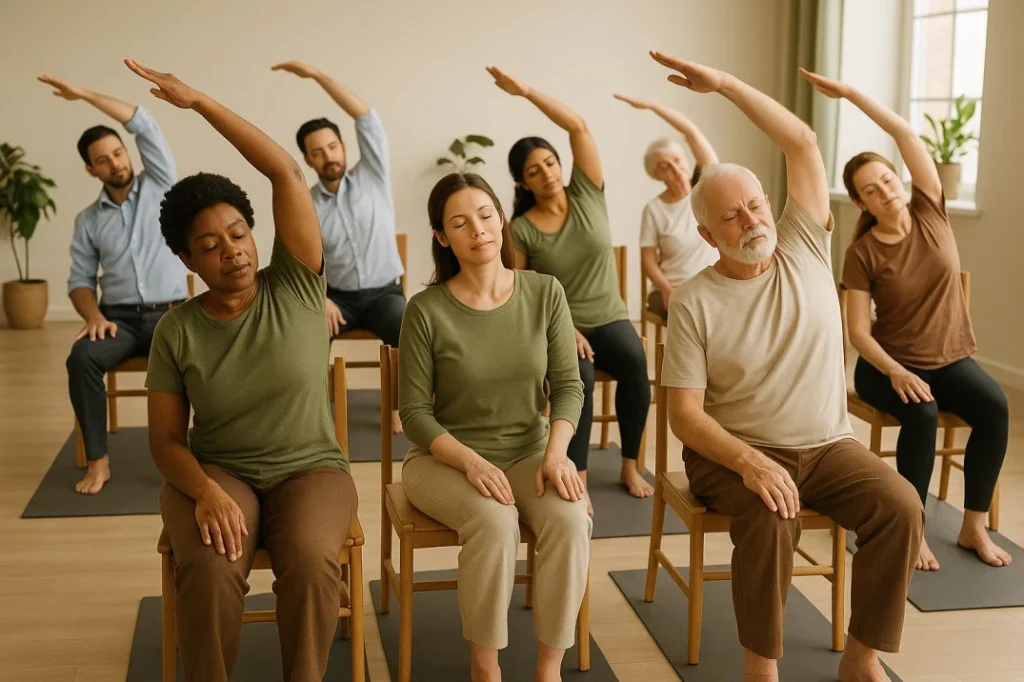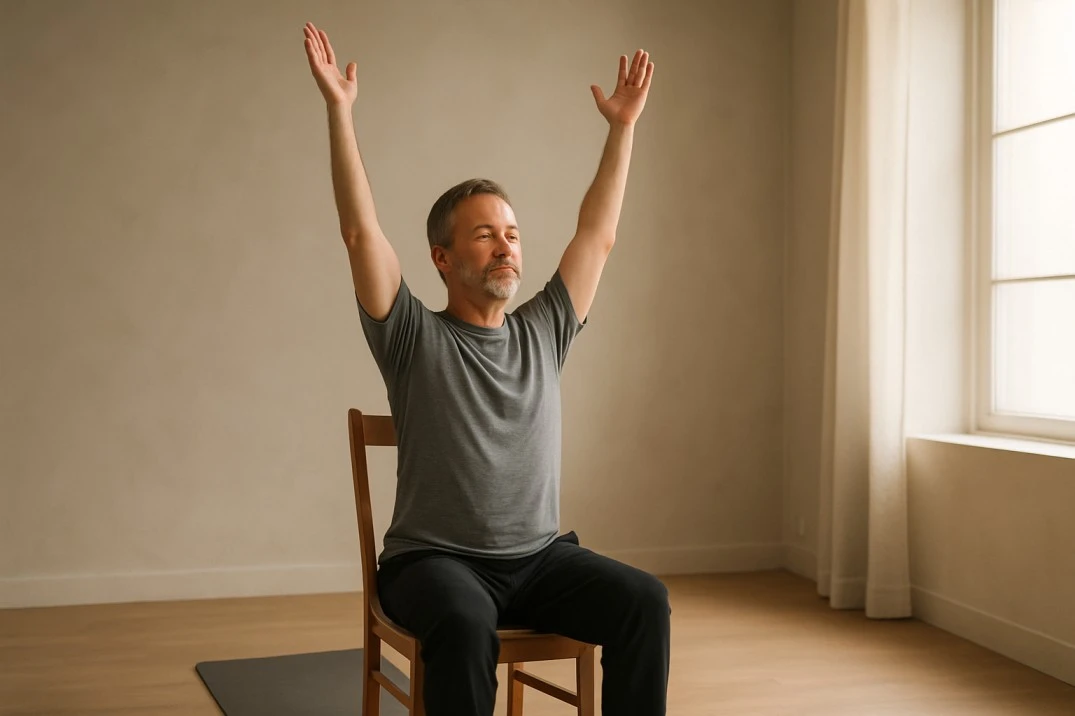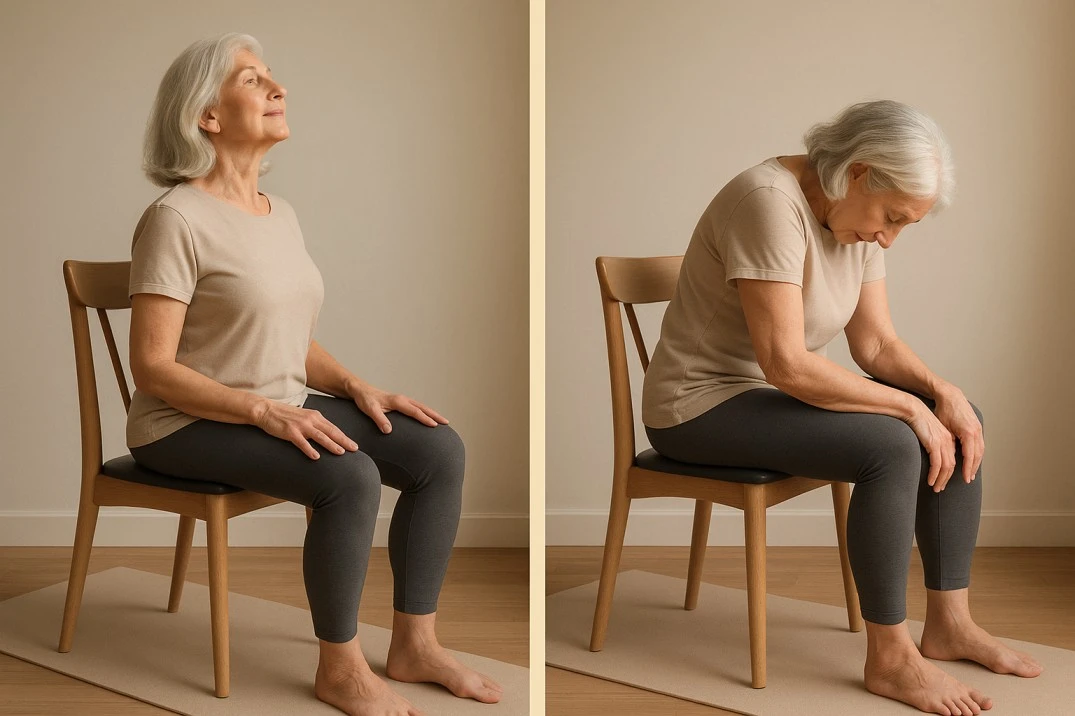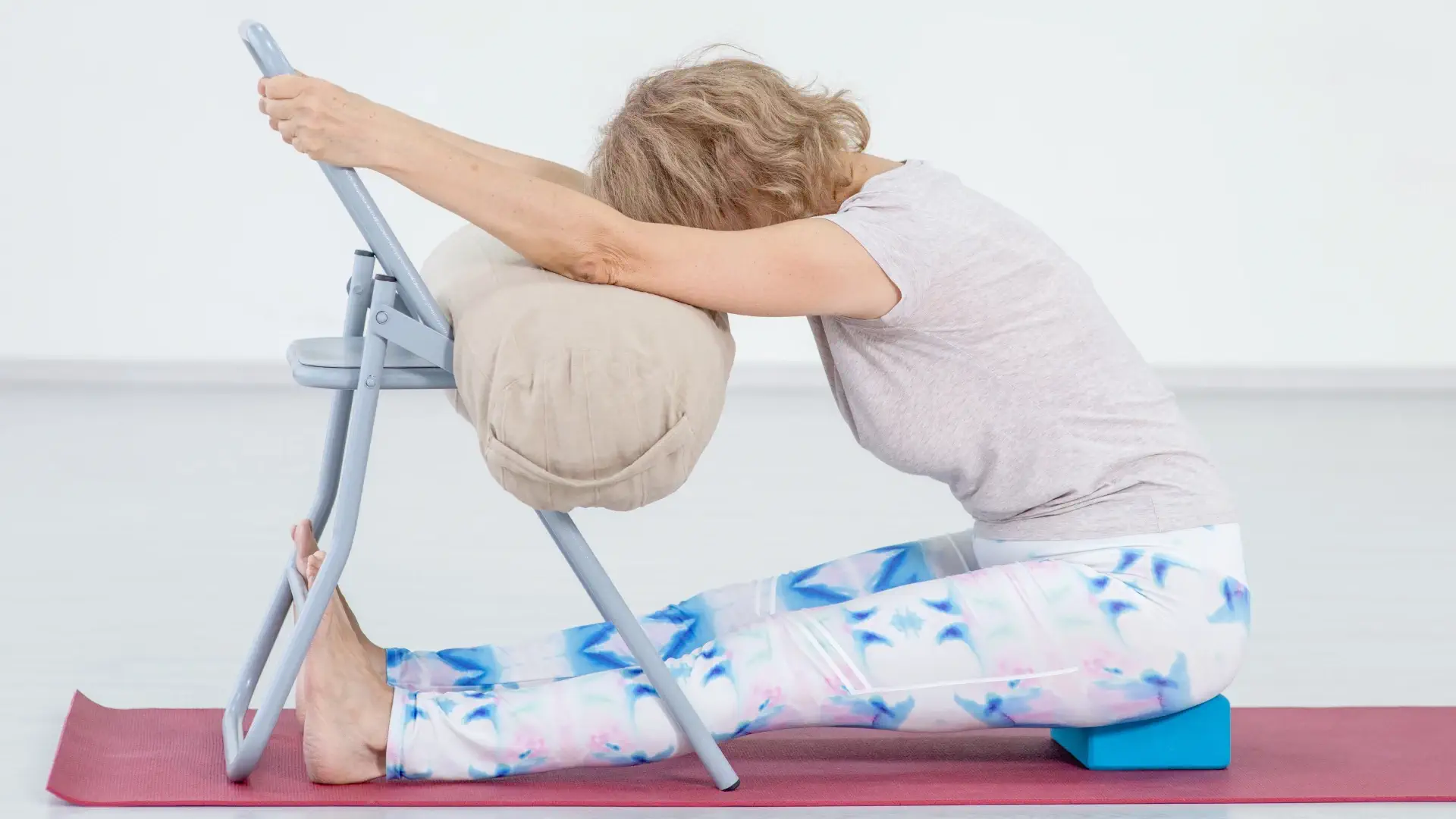
Top 8 Chair Yoga Sequence for Seniors with Osteoporosis
There are many benefits to doing chair yoga sequence for seniors with osteoporosis. Aging is inevitable, but staying healthy as you age is possible. As we age, our bodies undergo a variety of changes, from muscle weakness and wasting to decreased balance, limited mobility, and sleep disturbances. This is where a low-risk and effective physical and mental exercise like yoga can be beneficial for everyone, even those with osteoporosis.
Now, if you think you need a flexible body or a lot of space to practice yoga, chair yoga will change your mind! This method is an accessible version of yoga that is performed using a regular chair (with or without a back) and is designed for those who find it difficult to stand or sit on the floor. Chair yoga is not only suitable for seniors, but also for desk workers, beginners, and those in recovery. These exercises help improve balance, flexibility, focus, strengthen muscles, and reduce stress. In this Human Health Mag article, we introduce the most beneficial chair yoga for people with osteoporosis.
Why Is Exercise Good for Osteoporosis?
To fully understand the benefits of chair yoga sequence for seniors with osteoporosis, you don’t need to know complex biochemistry formulas. It’s enough to know a simple but fundamental scientific principle called “Wolf’s Law.” This law, proposed by a German surgeon more than a century ago, states that bone is a living tissue and will rebuild and adapt in response to the stresses placed on it. In simpler terms, “any stress you put on a bone makes it stronger.”
When you walk, climb stairs, or lift a light weight, your muscles contract and pull on tendons. These tendons, in turn, stretch and compress the bones. This mechanical stress is the best signal to wake up bone-forming cells (osteoblasts) to get to work and deposit more minerals in the area. In contrast, inactivity sends the exact opposite signal. When you’re sedentary for long periods of time, your body decides it no longer needs a strong, heavy skeleton to support your weight, and to conserve resources, it starts to strip minerals from your bones. The effect of exercise on osteoporosis has different goals at two key stages of life:
In your youth (up until about age 30): Building a bone reserve
- During this period, the main goal of exercise is to reach “peak bone mass.” This term refers to the highest level of strength and density your bones will reach during your lifetime. The higher your peak, the more reserves you’ll have to fight off natural bone loss in middle age and old age. High-impact, high-impact exercises are the best way to maximize this bone reserve during this time.

In middle age and old age: preserving capital and preventing bankruptcy
After the age of 30, the focus shifts from “building” to “preserving.” During this time, exercise has two main and vital goals:
- Slowing down bone loss: Regular exercise signals the body that it still needs strong bones, significantly slowing the rate at which minerals are removed from bones.
- Strengthening muscles and improving balance: As we age, muscle mass also decreases (a phenomenon called sarcopenia). Weak muscles and imbalance are the biggest risk factors for falls, and falls are the main cause of more than 90 percent of hip fractures. Exercise protects you from fractures indirectly but very effectively by strengthening muscles and improving balance.
So exercise not only directly helps maintain bone density, but also creates a multi-layered defense against the disastrous consequences of osteoporosis by building a supportive muscular system and increasing balance.
Chair Yoga and Its Benefits
Chair yoga sequence for seniors with osteoporosis is a series of modified yoga exercises that are performed while sitting or leaning on a chair. The goal of this method is to make yoga accessible to all bodies and ages, without requiring a lot of flexibility or difficult posture changes. Yoga is also on the list of seated cardio exercises for seniors in wheelchairs.
These exercises are inspired by the principles of Hatha Yoga and Restorative Yoga and help people enjoy the benefits of yoga even at work or at home, without the need for special equipment. Elderly people or those who suffer from joint pain, arthritis or limited mobility can keep their bodies relaxed and in harmony with chair yoga. The most important benefits of yoga are:
- Improved balance and coordination: Using a chair as a support in yoga exercises for seniors helps them maintain their balance and move with more confidence. These exercises are especially useful for preventing falls in the elderly.
- Increase flexibility: The bending and stretching movements of chair yoga put less stress on the joints. This feature allows the body to slowly regain its flexibility, especially in the pelvic area, shoulders and spine.
- Strengthen core muscles: Some movements, such as seated twists or leg raises, activate the abdominal and back muscles and help better support the spine.
- Reduce stress and improve concentration: Chair yoga is a relaxing practice that separates the mind from everyday anxiety and enhances the sense of presence in the moment. Regular breathing and focusing on the body release serotonin and a feeling of calm.
- Improve blood circulation and lower blood pressure: Gentle movements combined with deep breathing increase blood flow and help lower blood pressure، especially in people who are sedentary or have heart disease.

8 Chair Yoga Sequence for Seniors with Osteoporosis
Chair yoga sequence for seniors with osteoporosis is one of the safest ways to maintain mobility, flexibility, and vitality in old age. Contrary to popular belief, seniors can also do yoga exercises safely and with a sense of peace. However, it is recommended that people with problems such as osteoporosis, arthritis, or high blood pressure consult a doctor or trainer before practicing.
1- Ujjayi Breathing
- To do ujjayi breathing, slowly inhale through the nose and exhale with a soft sound in the throat.
- Benefits: Calms the nervous system and improves concentration.
2- Seated Sun Salutation Arms
- Raising the arms with an inhale, lowering them with an exhale.
- Benefits: Increases shoulder mobility and improves energy flow in the body.
- Practicing Sun Salutation in yoga with a chair to improve energy circulation and open the shoulders
3- Neck Stretch
- Bring the chin to the chest and then slowly turn the head left and right.
- Benefits: Reduces neck stiffness and improves blood flow to the brain.
4- Seated Spinal Stretch
- Sit straight in a chair, feet flat on the floor.
- Inhale, raise your arms and stretch your spine upwards.
- Exhale, gently lower your arms and release your shoulders.
5- Gentle Seated Twist
- Place your right hand on the back of the chair and your left hand on your knee.
- Slowly rotate your body to the right and take a few slow inhales and exhales.
- Then switch directions.
6- Seated Shoulder Opener
- Lock your hands behind your body.
- Open your chest, lift your chin slightly and take a deep breath.
- Stay in this position for a few seconds.
7- Seated Leg Lift
- Sit in a chair, feet flat on the floor.
- Raise one knee and hold for a few seconds, then switch.
- You can coordinate the movement with regular breathing for a more relaxing effect.
8- Chair Forward Fold
- Sit up straight, legs slightly wider than hip-width apart.
- As you exhale, bend forward from the hip joint until your stomach rests on your thighs.
- Place your hands on your feet or the floor and take a few slow inhales and exhales.
The Effect of Chair Yoga Sequence for Seniors With Osteoporosis
In old age, the range of motion of joints decreases and the muscles of various parts of the body atrophy. This, along with osteoporosis, which is the most common disease of the elderly, increases the risk of falls and fractures. Studies show that chair yoga sequence for seniors with osteoporosis directly contributes to improving balance and flexibility by focusing on the coordination of nerves and muscles.

In a study published in the journal Frontiers in Aging Neuroscience, people over 65 who participated in yoga sessions for 12 weeks showed a significant improvement in maintaining balance. In fact, yoga increases body awareness and is a key factor in preventing falls in the elderly by strengthening focus on body position during movements.
Many of the elderly around us complain of chronic pain such as arthritis, back pain or knee pain. Unlike high-pressure and hard exercises, yoga increases blood circulation, reduces local inflammation, and strengthens the muscles around them with gentle and controlled movements without putting direct pressure on the joints.
Tips for Protecting Joints When Exercising
If you haven’t been active for a while, start slowly with a chair yoga sequence for seniors with osteoporosis. Too much pressure on your body can strain your muscles and make joint pain worse. Consider these tips to get started:
- Use heat: Heat can relax your joints and muscles and ease any pain before you start exercising. Heat treatments, such as hot towels, packs, or hot showers, should be warm, not hot, and should be used for about 20 minutes.
- Move slowly: Move your joints slowly at first to warm them up. You may need to do some range-of-motion exercises for 5 to 10 minutes before doing yoga or aerobics.
- Use ice after exercise: Ice your joints for up to 20 minutes after exercise, especially after activities that cause joint swelling.
- Don’t overdo it: If you haven’t been active for a while, you may notice some soreness after exercising. In general, if you feel sore more than two hours after exercising, you’ve probably exercised too much. Talk to your doctor about what pain is normal and what is a sign of something more serious.
Concluding Remarks
Chair yoga sequence for seniors with osteoporosis is a treatment prescription and, like any other prescription, should be personalized to your unique situation. There is no one-size-fits-all exercise program. The most important step is to get started. You can start yoga slowly, gradually increase the intensity and duration, and never compare yourself to others. Listen to your body and always put safety first.
Remember that every step you take, every weight you lift, and every moment you spend improving your balance is a direct investment in an active, independent, and resilient future. Movement is key to maintaining quality of life at all ages, and it’s never too late to begin this powerful journey. Our team is here to help you build a stronger tomorrow by providing you with reliable and actionable information.
Could you help us make this content even better? What do you love, and what can we improve? Share your thoughts below, feedback is the key to creating better content for you.

Frequently Asked Questions
What Age Should We Start Exercising to Prevent Osteoporosis?
The best time to build maximum bone mass is during childhood and adolescence. But it is never too late to start exercising and strengthen your bones, and you can reap the benefits at any age.
How Many Times a Week Should You Practice Chair Yoga?
3 to 4 sessions a week for at least 3 months is enough, but even 10 minutes of regular practice a day can produce noticeable results.
